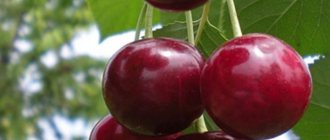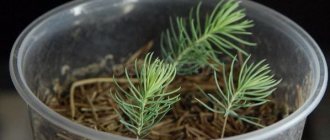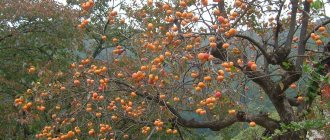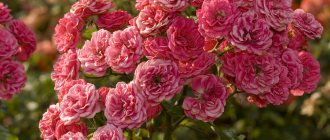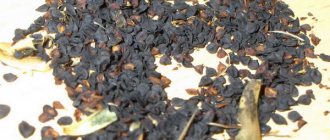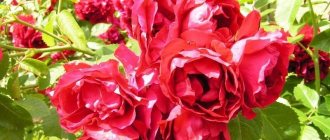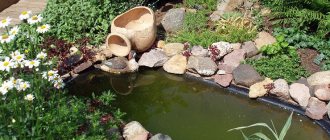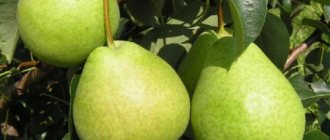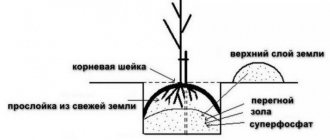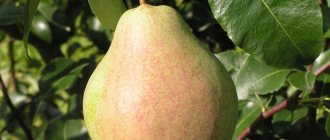Veles pear variety: yield, frost resistance, planting and care, reviews, description of the fruit tree
It is difficult to imagine a garden plot without fruit trees. Pears, apple trees, cherries and plums are essential attributes of any garden. The number and variety of these garden crops depends on the size of the plot and the preferences of its owners.
Since such trees grow and bear fruit for more than one season, it is important to choose the right variety based on its main characteristics, so that later you don’t have to regret that you didn’t get exactly what you wanted.
The content of the article:
1. History of breeding 2. Description and characteristics of the variety 3. Productivity of the Veles pear variety 4. Pollinator trees for Veles pears 5. Diseases and pests 6. Advantages and disadvantages 7. How to plant correctly 8. Further care for Veles pears 9. How feed pear trees 10. Timing and rules for pruning trees 11. Preparation for winter 12. Reviews of Veles pear
In this article we will talk about the pear. This fruit crop with a lifespan of more than 30 years is very hardy, tolerates periods of drought well, has good yields, and the fruits are tasty and sweet.
However, not all pear varieties are highly resistant to frost, and in Russia some regions have a harsh climate - a short summer period and cold winters.
EXCELLENT VARIETIES OF PEARS!
Pear variety Duchess summer Pear August dew
Not all fruit crops take root in such conditions. Thanks to the efforts of breeders, there are now many pear varieties with high frost resistance. One of these plants is the Veles pear, which can be grown in the middle zone and Moscow region, as well as in regions with similar climatic conditions.
The main characteristics and advantages of the Veles pear, planting and further care, pruning, frost resistance, reviews from gardeners and much more will be discussed in this article.
History of variety development
This pear variety was bred by Russian breeders Yu. A. Petrov and N. V. Efimova from VSTISP (Moscow) at the end of the last century. To develop a new pear, the varieties Venus and Forest Beauty were used. Another name for this fruit tree is “Daughter of the Excellent”. The variety passed the necessary tests and was included in the State Register of Russia in 2001.
This pear is zoned for the middle zone and Moscow region. But more often it is grown by gardeners from the Moscow region and nearby areas.
Veles pear - photo
Veles pear: description and characteristics of the variety
Veles pear is a late-ripening variety - the first fruits ripen in early August. The climate of not only the middle zone, but also other regions with moderately warm weather is suitable for its growth and fruiting.
This hybrid is medium tall. If you focus on the central trunk, then the height of the Veles pear is up to 4 meters
. The crown of young trees is spreading. But with age, many new shoots grow on this fruit tree, the crown thickens and takes on a spherical shape. Skeletal branches are thick, but they are elastic and durable.
Veles pear has a sufficient life expectancy - up to 30 years
. But with age, the yield of the variety decreases; experienced gardeners recommend anti-aging pruning to extend the life and fruiting life of this pear.
The foliage is typical of pear trees, oblong in shape with sharp tips, the color of the leaf blades is dark emerald, with a characteristic gloss on the outside. The leaves are slightly curved, with small teeth along the edges.
Photo of Veles pear
Flowers appear on the tree in May; they are large in size with bright white petals. The fruits are formed during the summer season.
The shape of ripening fruits is similar to a lantern - narrow at the stalk and very wide at the base. During the ripening period, the color of the thick skin is green, with a light green tint. But as they ripen, a red blush with an orange tint appears on the side of the fruit facing the sun, and the color of the fruit in the shade remains unchanged. As a result, ripe pears look very original and unusual. Ripe fruits have approximately the same size and weight - up to 200 g
. The skin is smooth, without roughness, with a light white coating. The best taste appears in fruits with the formation of a red blush.
For long-term storage, sale and transportation, it is recommended to remove slightly unripe fruits (without blush) from the tree. It works great at home, and the skin color turns yellow.
Important!
When picking a fully ripe pear, you need to remember that such fruits are not stored for a long time and quickly begin to rot. Therefore, the ripe crop is immediately processed.
The pear pulp is dense, juicy, with an oily aftertaste. Its color is white with a cream tint. The degree of maturity is determined by the brown color of small seeds located in the center of the fruit in the seed chambers. The taste of the juice is sweet with a small amount of acid.
Harvested pears are distinguished by their versatility of use - they can be eaten fresh, cooked in desserts, made into jam, preserves, and delicious juice. Collected unripe, the fruits can be stored in the cellar for up to 4 months without losing their commercial qualities and pleasant taste.
The Veles variety is highly resistant to frost and disease. However, in severe winter conditions (for example, in the Urals or Siberia), these pear trees should, if possible, be covered before the onset of winter.
Veles pear - video
Harvesting
Veles pear is a high-yielding variety. The yield of one mature tree reaches from 50 to 100 kg.
The first and largest Veles fruits can be harvested already in mid-August. This will relieve the tree a little and allow the remaining pears to ripen faster. Therefore, harvesting is carried out in 2-3 stages.
If you plan to store the pear, you need to collect slightly unripe fruits. Pears intended for fresh consumption or processing are removed after full ripening.
For storage, you need to select smooth, whole fruits, without dents or damage. Wrap each pear in thin paper or place it in a box and sprinkle with dry sand or sawdust. Fruits prepared in this way are stored in the refrigerator or in the basement until November. You just need to periodically inspect them to prevent mold or rot from appearing, and remove spoiled ones in a timely manner.
Velesa has good taste, so jams, marmalades, marmalades, compotes and confitures are excellent. There are a great many recipes and the main difficulty here is making a choice.
Whole pear jam
Veles pear produces very tasty juice, from which you can make wine if desired. In winter, dried fruits are used to make compotes, jelly, make filling for pies, add them to porridge and simply eat them as dried fruit.
Productivity of Veles pear variety
This pear is not characterized by early fruiting and usually produces the first harvest in the 5th or 6th season after planting in a permanent place
. However, some gardeners provide the tree with excellent care and achieve fruiting already in the third season from the moment of planting. But this is rather the exception than the rule.
In the first years, the yield of Veles is not too high, but it increases from season to season. So, a 10-year-old tree already produces 60-100 kg of ripe fruits
. Fruiting of this pear is regular; it does not have dormant seasons.
How to improve your harvest: tips and tricks
To fruitfully grow a pear and obtain high yields, experienced gardeners adhere to three main secrets that affect its size:
- Correct choice of location and planting of seedlings in compliance with generally accepted technology.
- Timely care not only for a young seedling during the adaptation period, but also for an adult tree.
- Careful preparation for wintering.
Timely completion of all the above stages allows the pear to feel comfortable at any time of the year, receive the sun, moisture and nutrients in the required volume.
The result of careful care will not be long in coming: the pear will thank gardeners with abundant flowering in the spring and large harvests in the fall.
Advantages and disadvantages
The main advantages of the Veles pear include:
- good presentation and taste, so the harvested crop can be used for further sale;
- the hybrid is highly resistant to diseases and attacks by insect pests;
- is resistant to frost and spring return frosts;
- ripe fruits contain a whole complex of vitamins, as well as a number of macro- and microelements that are beneficial for the human body;
- regular annual fruiting, and the yield increases annually.
Among the disadvantages of the Veles pear, it should be noted that with abundant formation of ovaries, the ripening fruits become smaller in size
. To eliminate this drawback, formative pruning should be carried out in the spring, during which excess shoots should be removed. Sometimes the kidneys freeze.
Diseases and pests
The Veles variety has good immunity to diseases and pests, but still they do not bypass it. To prevent trees from getting sick, it is necessary to do regular preventive maintenance. The drugs Skor and Topaz protect against powdery mildew diseases. They are sprayed before the buds bloom.
Before flowering, the drug Hom worked well. It is also used to prevent fruit rot.
After the crop is harvested, spray it with a solution of copper sulfate. This solution is also good for bacterial burns. Whitewashing the trunks with lime diluted in water helps prevent insects from entering cracks in the bark.
Veles pear: how to plant correctly
Veles pear requires a lot of sunlight, otherwise the fruits will gain less sugar and become too sour
. Therefore, the area for planting it should have sun throughout the day. This pear is afraid of gusts of cold wind and must be protected from it - this fruit tree is not planted in open areas.
Purchased Veles pear seedlings can be planted in open ground both in spring and autumn. To plant a Veles pear in the spring, the hole must be prepared in the fall. And when planting in autumn, you need to dig such a hole in April - May.
Planting a pear seedling
The time for planting this fruit tree in the autumn is September.
, you need to calculate the exact timing of this procedure in such a way that there are at least 14-18 days left before the onset of cold weather. Otherwise, the tree may not have time to take root and may freeze over the winter.
This pear is undemanding to the type of soil and its fertility
. However, for better growth and future productivity, it is better to apply fertilizers to the depleted soil in advance. The groundwater level should not be closer to the ground surface than 22-2.5 meters. The root system of this hybrid does not tolerate stagnation of moisture in the soil and waterlogging, otherwise the roots may rot.
Important!
Purchased seedlings should not have visible damage or traces of diseases of the crown and root system. You should not buy trees older than 2 years - they will take root worse and grow more slowly.
The depth of the planting pit must be at least 0.5 m
. A layer of nutrient substrate is placed at its bottom, consisting of garden soil mixed with peat or rotted mullein. Then 1.5-2 buckets of water are poured into the holes so that the soil settles. After 6-8 days you can start planting young trees.
A peg is driven into the hole, a seedling is placed in the center and tied to a support. Then the hole is filled with soil and compacted.
Important!
The root collar should be 9-11 cm above the soil level.
For each planted tree, add 20-30 liters of settled water
. The next watering is carried out in a few days. After this, a layer of mulch about 5-6 cm thick is introduced into the tree trunk circle. It is better to take mowed grass or foliage as a mulching element.
With proper planting, acclimatization of the pear occurs quickly, and after 12-14 days (when planting in spring), new foliage begins to appear on the branches.
Choosing a landing site
When choosing a place to plant a pear, you should remember that this plant is heat-loving, so it needs to be planted in a bright and sunny area. The growth of the tree and the sugar content of the fruit largely depend on this. Also, the pear should not be planted in an open area, since winds negatively affect the growth of the tree.
Veles pear can be planted both in autumn and spring.
In spring, the most favorable time for planting is April. Spring planting protects the pear from rodents. In addition, over the summer the root system will grow well, and the tree will be able to survive the winter better. But the hole for the seedling must be prepared in the fall, since a tree planted in a fresh hole suffers from soil subsidence.
In autumn, it is better to plant a pear in mid-late September or early October. In this case, the hole should also be prepared in advance so that the seedling has time to take root in the new place and is not damaged due to frost.
Further care for Veles pears
Further care for this pear consists of observing the irrigation regime, loosening the tree trunks while simultaneously removing weeds, mulching the soil, applying fertilizers, carrying out formative and sanitary pruning, and preparing the tree for the coming winter.
In the first year after planting, a growing Veles pear seedling requires more moisture than an adult tree, since the root system of young trees is still small and cannot extract moisture from the depths of the soil. Therefore, every 2-3 days, 20 liters of water are added to each tree.
Interesting!
Plum Morning Columnar apple tree Ostankino Peach Redhaven
Adult trees also require watering, but much less often
. Pears are especially sensitive to soil drying out in the period before flowering. At this time, a large volume of water is applied to each tree at a time - up to 40 liters. Then weekly you need to add 1-1.5 buckets of water to the tree trunk circles.
The next abundant watering is carried out during the period when fruit formation begins, when the pear also really needs moisture.
However, mature pear trees should not be over-watered.
– their taproot system has grown sufficiently, so it is able to select moisture from the soil on its own.
Care
In order for a pear tree to bear fruit regularly and abundantly, it needs to be provided with high-quality care. The plant should be watered, fed, cut off old branches, loosened the soil, and also ensure that there are no weeds. It is necessary to prevent the appearance of pests, carry out preventive measures in a timely manner and fight diseases.
Watering
A young seedling needs frequent watering. Depending on the weather, the tree is watered 2-3 times a week (2 buckets of water per tree). An adult tree needs watering 3-4 times a month.
Watering is carried out in the early morning hours or in the evening.
A ditch about 15 cm deep is dug around the tree, then water is poured into it. This way the water will be distributed throughout the earth, and the roots will take as much moisture as they need.
Trimming
A young pear tree is subjected to the first pruning before planting, shortening all branches by one third. This is how the future crown is formed. Subsequent pruning is done in the spring (before the buds swell).
In mature trees:
- branches are completely removed if they are partially or completely lying on the ground;
- cut off weak shoots;
- Be sure to remove all old and diseased branches.
Important! You cannot cut many branches at the same time. The volume of removed branches should be one quarter of the total.
The cut areas are treated with garden varnish, oil paint or Rannet putty paste in accordance with the instructions for use.
Rannet paste adheres well to the surface of cuts, forming a durable coating, does not crack, does not harden in cold weather, and is easily applied to cuts with a brush.
Preparing for winter
When preparing pear trees for winter, you should remove leaves and fallen fruits. They are burned or sent to a compost bin.
Measures to prepare trees for winter:
- The tree trunk is whitened with a solution of lime and clay (1.5 kg of clay and 2-2.5 kg of lime per bucket of water).
- They dig up tree trunk circles and then cover them with a layer of sawdust or peat (20-25 cm).
- The branches of a young pear are tied to the trunk.
- To protect the tree from rodents, wrap the trunk with spruce branches (needles down). The trunk can also be covered with brushwood, roofing felt, or plaster shingles. To prevent small pests, the trunks and branches of pear trees are tied with old nylon tights or stockings. In winter, during heavy snowfalls, the snow around the tree is carefully trampled down so that mice cannot reach the trunk under the snow.
How to feed pear trees of the Veles variety
Fertilizers should be applied to the tree trunks of this fruit crop several times a season.
The first time feeding a pear tree is done in the spring before budding begins.
. In this case, ammonium nitrate, urea or urea are added to the soil.
You need to feed this tree a second time immediately after flowering has ended.
. It is better to use organic matter as a top dressing. A round trench is dug along the edge of the tree trunk circle, into which food waste, weeds (without seeds), leaves, and rotted mullein are placed. Then the trench is filled in and watered well.
For the third time, fertilizers are applied to the Veles pear in the process of preparing the tree for winter - in the second ten days of September
. This time you need to add mineral fertilizers containing phosphorus and potassium, as well as wood ash.
Important!
Nitrogen-containing fertilizers are not applied to fruit trees in the autumn.
Preparing for winter
The Veles pear variety survives cold winters well. But preparing a tree for winter protects it from low temperatures and pests that overwinter in the roots or bark of the tree.
In autumn it is necessary to collect all the fruits from the tree. Next, you need to gather leaves around the trunk and dig through the ground. This procedure is necessary to ensure that the roots receive more oxygen and to remove insects.
Also, the tree trunk and the base of the main branches need to be treated with a solution of chalk and lime.
Veles pear is a real find for gardeners. Not only does this variety have beautiful and large fruits, but they are in no way inferior in taste to many other varieties. Tasty, sweet and fleshy fruits ripen closer to autumn , remain on the tree for a long time, and even when picked, retain their taste for a long time. In addition, the variety does not require special care and is resistant to cold, diseases and pests.
Veles pear: terms and rules for pruning trees
In the first two seasons after planting, Veles pear seedlings do not require pruning, since their crown is just beginning to form during this period.
From the third season you need to start pruning
. First of all, all branches growing at an angle of 90 degrees are removed. Only those shoots that grow at an angle of 65-70 degrees to the central trunk are left.
The remaining shoots of the Veles pear are cut to approximately 1/3 of their length. The central trunk is also subject to pruning, but its height after this procedure should be 25-30 cm greater than the other branches.
In season 4, all young branches are pruned.
In spring and autumn, sanitary pruning must be carried out
, removing any broken, damaged or dried shoots. In summer, pruning is carried out in extreme cases - if only it is necessary to remove areas of shoots damaged by disease or pests.
When pruning branches, you can leave small stumps near the central trunk.
How to prune a pear correctly
Trimming
Veles is advised to prune at the end of February. It is worth remembering that culture does not easily tolerate such manipulations, so you need to act carefully. What to avoid when pruning:
- Thin branches directed vertically or at an acute angle (tops).
- Injured or dried branches.
- Branches shading each other.
- Branches looking deep into the crown.
Rejuvenating pruning is also required, which involves cutting all branches to such a length that you can easily care for the plant.
The more the pear is pruned, the more tops are tied on it.
Veles pear: reviews from those who grow
At the end of the article, a number of reviews should be given from gardeners from different regions of Russia who have Veles pear growing in their garden plot.
Elena, 44 years old, Ryazan region: On my pear of this variety, the first harvest appeared only in the 4th year - 6 fruits were picked. It turned out that the taste of this pear improves when a red blush appears on the sides. The fruits became sweet and juicy. Just for fun, one pear was put into the cellar to check how long it could be stored. The pear began to spoil only in December.
Volodya, 50 years old, Voronezh region: Four seasons after planting, my Veles pear blossomed, but for some reason the pears did not set. Maybe she still needs pollinating trees nearby? Next year a young pear of a different variety will begin to bloom nearby - I’ll look at the result.
The Veles pear is ideal for growing in central Russia - it does not freeze, and bears fruit starting from 5-6 years, and the yields become larger every year.
When grown in the sun, the fruits of this variety are very sweet and juicy. Therefore, gardeners who decide to plant a new pear variety in their garden should take a closer look at the Veles hybrid.
Reviews
Valery Sergeevich, Saratov: Once Velesa was very cold, but she quickly recovered. That year it yielded less, but now everything is fine. An amazing variety that we are very pleased with. I recommend it to everyone who lives in cold regions.
Larisa, Longitudinal : This variety has been growing at our dacha for a very long time. All this time, the plant pleases with a constant and stable harvest. Pears are very tasty and juicy, children especially like them.
Alena Moroznaya, Moscow region. : I recently planted Veles on the plot, and now the harvest has been harvested. The taste is the best pear I have ever tasted. If you live in Central Russia, be sure to take note of this variety!

